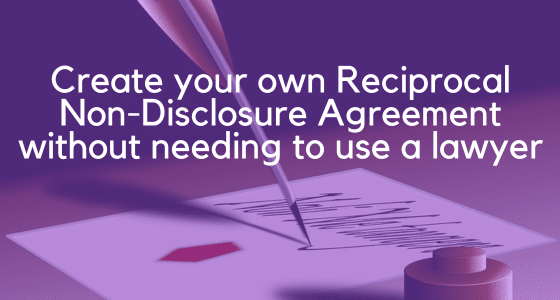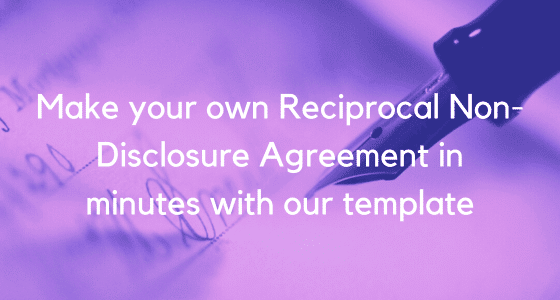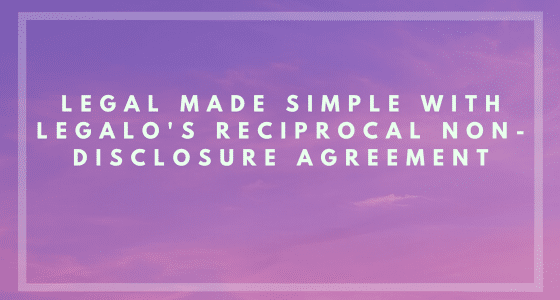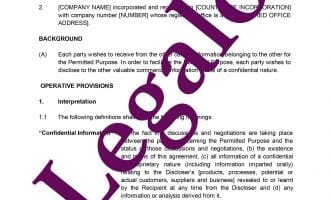Reciprocal Non-Disclosure Agreement
Our Reciprocal NDA template:
- Good value peace of mind
- Simple to customise to your requirements
- Drafted by a UK Lawyer for reliability
- Uses plain English

How Does It Work?
-
1. Download
-
2. Edit
-
3. Print
-
4. Sign
If your business needs to enter into an agreement with another to disclose private information or ideas between each of you, then you will need to have a Reciprocal Non-Disclosure Agreement in place. We have had a very experienced UK solicitor draft this template for you for this purpose. It is in clear and concise English, so that it is easy to use.

About our Reciprocal Non-Disclosure Agreement template
A Reciprocal Non-Disclosure Agreement can also be known as a Two-Way or Mutual Non-Disclosure Agreement. They will do the same thing and protect both parties who are exchanging any confidential information. You could use this agreement, for example, when two businesses need to work together to bring a product to market. If this is a situation where both of the participants would need to exchange confidential information in order to work together, and neither company wants to have their secrets compromised, then you need this agreement in place.
Signing the Reciprocal Non-Disclosure Agreement at the outset will be important, if you are considering entering into:
- a partnership;
- joint venture; or
- other contract with another business.
This agreement also is a powerful tool in case the planned partnership, joint venture or contract doesn’t go through. The parties involved will still be held to the same confidentiality agreement, so you know your idea or product will still be protected.
Anyone that is in business should not have a problem signing the Reciprocal Non-Disclosure Agreement. Because this Reciprocal Non-Disclosure Agreement protects both parties equally, it should be easy to get both parties to agree to sign it.
Using our Reciprocal Non-Disclosure Agreement template
You should get this reciprocal non-disclosure agreement in place before either party makes verbal or written disclosures of confidential information or ideas. Once you have purchased the template, you will be able to reuse it again and again. So it is available whenever you need it, at no further cost. You can download the template to your computer in Word format.
If you are only disclosing confidential information in one direction, then you may find our One-Way Non-Disclosure Agreement more suitable than a reciprocal non-disclosure agreement. Click on the link.
For a preview of the guide to this template, please see our very similar Simple NDA. Then scroll down to the heading “Clauses in this Simple NDA”.
Free updates for life
Should anything change with UK law that affects this template:
- we will update it;
- notify you; and
- then provide you with the updated version at no additional cost.

FAQs on Reciprocal NDAs
Below, we’ve answered the top questions from the Internet on reciprocal NDAs.
What is a reciprocal non-disclosure agreement?
An NDA or Reciprocal Non-Disclosure Agreement:
-
is an agreement between two parties or more than two parties;
-
specifies that the parties will disclose certain confidential information with the other party; and
-
states that the parties will not use or disclose the information for any other purpose other than the purpose for which they have been given the information.
The mutual nature of the agreement ensures that both parties’ sensitive information is protected and both parties maintain confidentiality.
How to write a mutual NDA?
When you decide to write a mutual NDA or non disclosure agreement, it is important to include the following:
-
You will need to identify the parties and clearly state their names and contact information.
-
You must define confidential information so that you know what information the parties will treat as confidential.
-
Outline the obligations of each party with regard to confidentiality. Limits must be placed on disclosure and use.
-
A duration of the agreement’s validity must be agreed. How long will the shared information remain confidential?
-
Specify the country whose laws will govern the agreement.
-
All parties must sign and date the NDA.
-
Ensure that the document complies with laws to which it applies and your interests are protected.
Can I make my own non-disclosure agreement?
Yes, you can create your own non-disclosure agreement (NDA) as long as it effectively outlines the terms of confidentiality and is legally enforceable. At Legalo, we have drafted an NDA that you can use, safe in the knowledge that it protects your interests. When using our great template, you don’t need to worry about “reinventing the wheel”.
What are the 2 types of non-disclosure agreement?
There are two types of primary non-disclosure agreement and they are as follows:
-
Unilateral or one-way NDA which involves one party sharing confidential information with another party. That party agrees to maintain its confidentiality.
-
A mutual, two-way or reciprocal NDA where both parties share confidential information and agree that the information that they have disclosed between themselves remains confidential. You would use this form of NDA when each party has confidential information that they are sharing, but they wish that information to remain confidential.
What is the purpose of a reciprocal agreement?
A reciprocal agreement is designed to ensure that two or more parties can share confidential information, whilst being comfortable that the information will not be shared with outsiders or misused. You use this sort of agreement when there are a number of parties who are working together with sensitive information and must ensure safeguards for their interests.
Does a non-disclosure agreement go both ways?
Yes, a non-disclosure agreement (NDA) can go both ways in a mutual or reciprocal NDA. In such agreements, both parties commit to not disclosing each other’s confidential information, creating a mutual obligation to maintain confidentiality. However, in a unilateral NDA, only one party shares confidential information, and the other party must keep it confidential, making it a one-way confidentiality commitment.
What is a 3 way non-disclosure agreement? What is a non-disclosure agreement between 3 parties?
A 3-way non-disclosure agreement, also known as a tripartite NDA, involves three parties agreeing to share and protect confidential information. It establishes mutual obligations among all three parties to maintain confidentiality. You use tripartite NDAs when each party needs to disclose sensitive information to the other two parties, and wants assurance that all parties will protect the shared information. This ensures that all parties can collaborate while safeguarding their respective interests and intellectual property.
What makes a non-disclosure agreement legally binding?
There are some essential elements that an NDA will contain to become legally binding.
-
Offer and acceptance: By one party “offering” confidentiality and the other party “accepting” the agreed terms.
-
Consideration: the parties must exchange something of value for the parties’ commitment to keeping it confidential.
-
Clearly-defined terms: The agreement must have clearly defined terms It must specify what information is confidential and what time period that obligation lasts for.
-
Legal capacity: All the parties entering into the contract must have the legal capacity to do so.
-
Lawful purpose: The purpose of the NDA must not be illegal.
-
Signatures: Both parties must sign the document without duress.
Do you need an indemnity clause in a NDA?
An NDA wouldn’t normally include an indemnity clause, as proving financial loss due to the release of confidential information is tricky. Our NDA template does not include an indemnity for this reason. If you can demonstrate breach and consequent loss, you can still sue in the Courts for damages, even without an indemnity clause.



